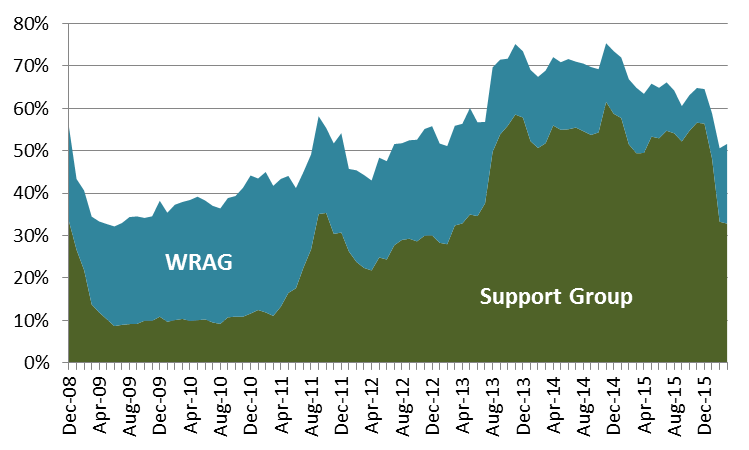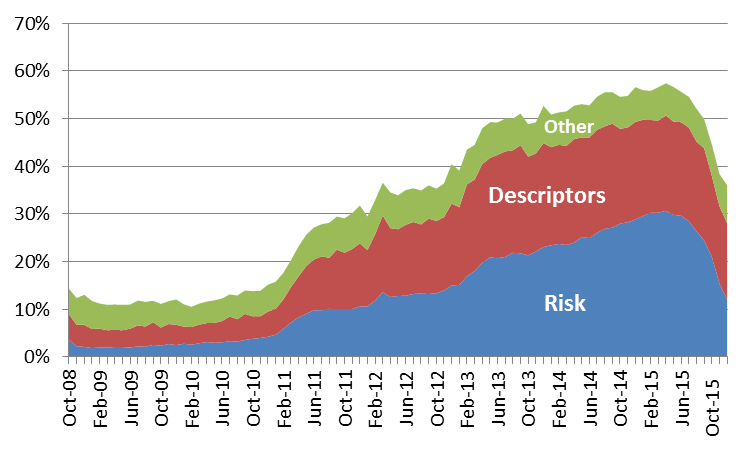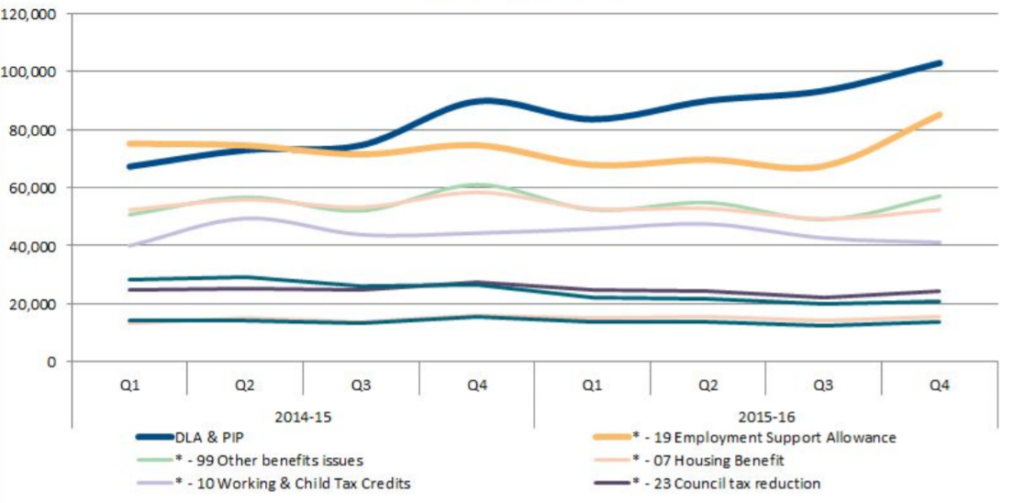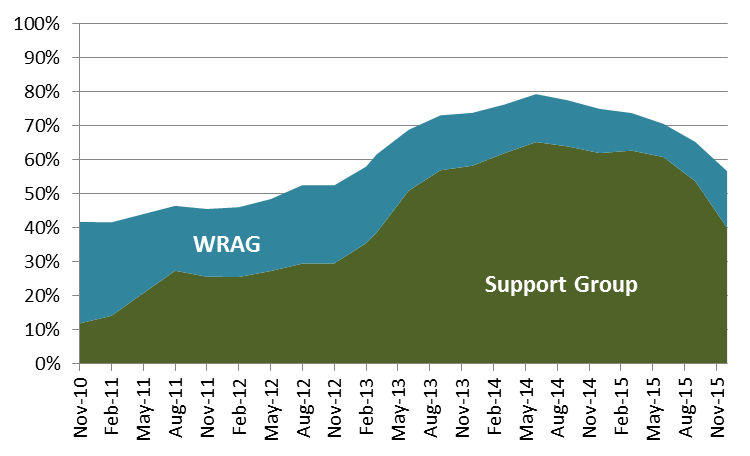The Work Capability Assessment (WCA) has for several years now been widely felt to be a harsh and unfair assessment of incapacity, as I’ve explored elsewhere. But what escaped some people’s notice was that it became a much more lenient assessment over time. Whereas two-thirds (67%) of those having an initial assessment in mid-2009 were getting found fit-for-work, this dropped to merely one-quarter (25%) in Nov 2014. Conversely, only 10% in mid-2009 were being allocated to the Support Group, compared to over 60% in Nov 2014. (The remaining people were allocated to the Work-Related Activity Group or ‘WRAG’, which is means-tested and in which people can be sanctioned to some degree).
However, the latest figures suggest the WCA is starting to become stricter again, as Disability News Service reported last week. The chart below looks divides the WCA outcomes by when the assessment takes place (rather than when the claim is made). In March this year, 48% of people were found fit for work, the highest figure since Feb 2013, while only 33% were found eligible for the Support Group. To the extent that the WCA became more generous in recent years, we now seem to be seeing a return to the WCA of 2013 – a time before the final two reviews of the WCA by Paul Litchfield, before the Work and Pensions Select Committee’s influential report, and a time when Atos still did incapacity assessments (and was roundly criticised for it).
Figure 1: Outcome of completed assessments (initial assessments before appeals, by month of assessment)

EXPLAINING THE WCA TRENDS
Yet there has been no policy change in the WCA – no change in the functional descriptors that make up the assessment, no ‘cut’ announced as part of Budgets or Spending Reviews – so what exactly is going on here?
One possible explanation – raised on Twitter by Declan Gaffney – is around the backlog of WCAs. Anecdotally, it seems that in the later days of Atos, they were doing more ‘easy’ paper-based WCAs of severely disabled people (which ended up in the Support Group), while the backlog was growing for people who were more marginal decisions who needed a face-to-face assessment. If Maximus have started clearing the backlog of (more marginal) face-to-face assessments, then this would lead to a fall in the number of people going into the Support Group, and a rise in those found fit-for-work. Yet as far as I can tell, this cannot explain the apparent increasing strictness of the WCA.
If we try and estimate the backlog from the WCA data1, it looks like there were nearly 300k pending initial assessments at the peak in mid 2014, which has since declined to 185k. The rate of decline has recently increased (70k in the last quarter, vs. 35k in the quarter before that), which is quite substantial within the total of 100-130k initial assessments per quarter. However, the main statistics allow us to look at outcomes by month of claim, and if we focus on people claiming in the most recent 3 months of each release (which admittedly involves putting together lots of spreadsheets), then we can ensure that we are ignoring the backlog. The results of this are shown below – and show exactly the same trend: in claims made in Apr-Jun 2015 (as of the Mar 2016 data release), 61% were allocated to the Support Group and 10% to the WRAG, but in claims made in Oct-Dec 2015 (in the Sep 2016 release), only 40% were allocated to the Support Group and 17% to the WRAG.
Figure 2: Ignoring the backlog: outcome of initial assessments for latest 3mths of claims (by most recent month of claim in each successive data release)
Another explanation is that this is something to do with ‘Regulation 35’ (as Ken Butler of Disability Rights UK and Anita Bellows of DPAC argued in the Disability News Service report), in which people can be allocated to the Support Group because of a risk to their health, even if they do not have enough points from the functional descriptors assessment. (They can also be allocated to the WRAG due to the parallel ‘Regulation 29’). The DWP have changed the guidance around this in deliberate response to the massive expansion in the use of what was meant to be an ‘exceptional’ circumstance – by mid 2015, over 30% of all completed assessments resulted in someone being assigned to the Support Group on these grounds, noticeably greater than the 20% relying on the actual functional descriptors. The final Litchfield review made clear that this was regarded as something that had to change, so we have been expecting DWP to do something in this area.
The revised guidance to healthcare professionals was released in July 2016 – you can compare the relevant sections to the 2015 guidance in this document I’ve created here. (You can also see the guidance in 2015 and 2016 appendices: the 2016 version is effectively brand-new. The 2015 updated version to DWP Decision Makers is here). While the detailed message of what has changed is complex, the basic message is clear: assessors are discouraged from saying that there is a substantial risk to the claimant’s health if they are found capable of work (or work-related activity). There are three aspects to this: ‘the focus on suicide has been reduced’ (as the DWP put it), the bar for ‘substantial risk’ has been raised, and the DWP has emphasised that “claimants must not be asked by DWP to do anything that is unrealistic or could put their health at risk” – hence they argue that it would be rare for work-related activity to cause difficulties for claimants.
So can this explain the changing WCA outcomes? The guide to healthcare professionals nots that “the Revised Substantial Risk Guidance was issued by the DWP in 2015 and implemented early 2016”, so we should just be about to see the impact of it now. And we do. From claims begun in Jun-15 to Dec-15, people allocated to the Support Group due to Reg35 dropped from 30% of completed assessments to merely 12%. In contrast, Support Group allocations for other reasons stayed basically the same (reducing from 26% to 24% of claims).
Figure 3: Reason for being allocated to Support Group, completed assessments after appeals by month of claim

To my mind this is all pretty convincing – it has become harder to get allocated to the Support Group from the start of 2016, because the DWP has made it harder for assessors to make judgements on the grounds of a a risk to people’s health.
A CRISIS IN 2017?
Does this mean that we are returning to the old days of the WCA circa 2013? Time will tell if the recent figures are the new normal. But there are reasons to believe that a reversion to the 2013 WCA severity may actually cause more of a crisis than previously:
- ESA reassessments are now being re-introduced. ESA reassessments were suspended in Jan 2014, reaching 1m suspended reassessments by Aug 2015 (NAO report #1.12). But these now seem to have resumed, with 31k reassessments in Mar 2016 (up from about 10k/mth for most of 2015) – so more assessments are happening than usual while the backlog is cleared.
- There are extra hurdles in appealing WCA decisions. With the introduction of mandatory reconsideration in late Oct 2013, it is harder to put in an appeal against a WCA judgement – with the result that appeal levels fell through the floor. (For claims starting in most of 2012, there were 6-7k appeals per month, which dropped to 1k/mth after mandatory reconsideration was introduced. Before MR successful appeals were 2-3k/mth; afterwards it was less than 1k/mth). If the initial WCA returns to its previous levels of severity initially, then the final level will end up being more severe, because fewer people will appeal (and therefore fewer people will overturn the initial decision).
- The benefit in the ESA WRAG group is getting substantially cut. WRAG claimants will get a £30/wk benefit cut in April 2017, which I previously argued will considerably increase the pressure on the WCA.
Obviously this might not happen – confidently predicting the future is a mug’s game, as the last two years’ of elections (and most of human experience) have shown – and hopefully the current version of the WCA will work much better than previously, even if it is similarly difficult to get. But this is just a hope, and the possibility of a ESA/WCA-related crisis seems higher in 2017 than it has done for some time.
[Added note 22nd Sep: @KayleyHignell also noted that Citizens Advice have seen a sudden rise at the start of 2016 in people coming to them with ESA issues, as shown below (from this p17):

Footnote
1 DWP do not provide regular updates of the WCA backlog. I have created these figures by looking at the number of assessments marked as ‘in progress’, which obviously includes a certain number that are still within the target wait of 7 weeks. These numbers do not precisely match the number that the DWP report as the ‘backlog’, which they seem to estimate as the pending claims minus the ‘expected outstanding volume’ of 1.5 x the latest month’s claims, and which seems to include claims not yet referred to Atos/Maximus, and possibly also some reassessments that have been put on hold. However, the estimated backlog of 280k in Aug 2015 is similar to the ‘in progress’ WCAs for initial and repeat assessments using my method. (The official backlog is also reported as 500k Mar 2015 and 110k Oct 2015; see the NAO report #1.12 and Maximis General Manager Leslie Wolfe at this Select Committee Evidence Session).
